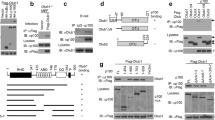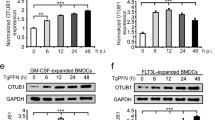Abstract
The NF-κB family of transcription factors is activated in response to many stimuli, including pro-inflammatory cytokines, environmental stresses and, in the case of B and T lymphocytes, by antigenic stimulation1,2. Bcl10 is essential for NF-κB activation by T- and B-cell receptors. T and B lymphocytes from Bcl10-deficient mice fail to activate NF-κB in response to antigen-receptor stimulation and, as a consequence, are unable to proliferate3. Bcl10 overexpression is sufficient to activate NF-κB, a process that requires the NF-κB essential modulator NEMO (also known as IKK-γ), which is the regulatory subunit of the IκB kinase complex4. However, the cellular mechanism by which Bcl10 activates the NF-κB pathway remains unclear. Here we show that Bcl10 targets NEMO for lysine-63-linked ubiquitination. Notably, a mutant form of NEMO that cannot be ubiquitinated inhibited Bcl10-induced NF-κB activation. Paracaspase and a ubiquitin-conjugating enzyme (UBC13) were both required for Bcl10-induced NEMO ubiquitination and subsequent NF-κB activation. Furthermore, short interfering RNAs that reduced the expression of paracaspase and UBC13 abrogated the effects of Bcl10. Thus, the adaptor protein Bcl10 promotes activation of NF-κB transcription factors through paracaspase- and UBC13-dependent ubiquitination of NEMO.
This is a preview of subscription content, access via your institution
Access options
Subscribe to this journal
Receive 51 print issues and online access
$199.00 per year
only $3.90 per issue
Buy this article
- Purchase on Springer Link
- Instant access to full article PDF
Prices may be subject to local taxes which are calculated during checkout




Similar content being viewed by others
References
Silverman, N. & Maniatis, T. NF-κB signaling pathways in mammalian and insect innate immunity. Genes Dev. 15, 2321–2342 (2001)
Dixit, V. M. & Mak, T. W. NF-κB signaling: Many roads lead to Madrid. Cell 111, 615–619 (2002)
Ruland, J. et al. Bcl10 is a positive regulator of antigen receptor-induced activation of NF-κB and neural tube closure. Cell 104, 33–42 (2001)
Lucas, P. C. et al. Bcl10 and MALT1, independent targets of chromosomal translocation in malt lymphoma, cooperate in a novel NF-κB signaling pathway. J. Biol. Chem. 276, 19012–19019 (2001)
Rothwarf, D. M. & Karin, M. The NF-κB activation pathway: a paradigm in information transfer from membrane to nucleus. Sci. STKE 5, RE1 (1999)
Ben-Neriah, Y. Regulatory functions of ubiquitination in the immune system. Nature Immunol. 3, 20–26 (2002)
Hoffmann, A., Levchenko, A., Scott, M. L. & Baltimore, D. The IκB-NF-κB signaling module: temporal control and selective gene activation. Science 298, 1241–1245 (2002)
Willis, T. G. et al. Bcl10 is involved in t(1;14)(p22;q32) of MALT B cell lymphoma and mutated in multiple tumor types. Cell 96, 35–45 (1999)
Zhang, Q. et al. Inactivating mutations and overexpression of BCL10, a caspase recruitment domain-containing gene, in MALT lymphoma with t(1;14)(p22;q32). Nature Genet. 22, 63–68 (1999)
Thome, M. & Tschopp, J. TCR-induced NF-κB activation: a crucial role for Carma1. Bcl10 and MALT1. Trends Immunol. 24, 419–424 (2003)
Uren, A. G. et al. Identification of paracaspases and metacaspases: two ancient families of caspase-like proteins, one of which plays a key role in MALT lymphoma. Mol. Cell 6, 961–967 (2000)
Shi, C. S. & Kehrl, J. H. Tumor necrosis factor (TNF)-induced germinal center kinase-related (GCKR) and stress-activated protein kinase (SAPK) activation depends upon the E2/E3 complex Ubc13-Uev1A/TNF receptor-associated factor 2 (TRAF2). J. Biol. Chem. 278, 15429–15434 (2003)
Deng, L. et al. Activation of the IκB kinase complex by TRAF6 requires a dimeric ubiquitin-conjugating enzyme complex and a unique polyubiquitin chain. Cell 103, 351–361 (2000)
Weissman, A. M. Themes and variations on ubiquitylation. Nature Rev. Mol. Cell Biol. 2, 169–178 (2001)
Wang, C. et al. TAK1 is a ubiquitin-dependent kinase of MKK and IKK. Nature 412, 346–351 (2001)
Hoege, C. et al. RAD6-dependent DNA repair is linked to modification of PCNA by ubiquitin and SUMO. Nature 419, 135–141 (2002)
Makris, C., Roberts, J. L. & Karin, M. The carboxyl-terminal region of IκB kinase gamma (IKKγ) is required for full IKK activation. Mol. Cell. Biol. 22, 6573–6581 (2002)
Smahi, A. et al. Genomic rearrangement in NEMO impairs NF-B activation and is a cause of incontinentia pigmenti. Nature 405, 466–472 (2000)
Yamaoka, S. et al. Complementation cloning of NEMO, a component of the IκB kinase complex essential for NF-κB activation. Cell 93, 1231–1240 (1998)
Harhaj, E. W. et al. Somatic mutagenesis studies of NF-κB signaling in human T cells: evidence for an essential role of IKKγ in NF-κB activation by T-cell costimulatory signals and HTLV-I Tax protein. Oncogene 19, 1448–1456 (2000)
Ohi, M. D. et al. Structural insights into the U-box, a domain associated with multi-ubiquitination. Nature Struct. Biol. 10, 250–255 (2003)
Ghosh, S. & Karin, M. Missing pieces in the NF-κB puzzle. Cell 109, S81–S96 (2002)
Kovalenko, A. et al. The tumour suppressor CYLD negatively regulates NF-B signalling by deubiquitination. Nature 424, 801–805 (2003)
Brummelkamp, T. et al. Loss of the cylindromatosis tumour suppressor inhibits apoptosis by activating NF-κB. Nature 424, 797–801 (2003)
Trompouki, E. et al. CYLD is a deubiquitinating enzyme that negatively regulates NF-B activation by TNFR family members. Nature 424, 793–796 (2003)
Harbury, P. B. et al. A switch between two-, three- and four-stranded coiled coil in GCN4 leucine zipper mutants. Science 262, 1401–1407 (1993)
Li, M. et al. Deubiquitination of p53 by HAUSP is an important pathway for p53 stabilization. Nature 416, 648–653 (2002)
Moraes, T. F. et al. Crystal structure of the human ubiquitin conjugating enzyme complex, hMms2-hUbc13. Nature Struct. Biol. 8, 669–673 (2001)
Acknowledgements
We thank members of the Dixit laboratory for discussions and support; K. Newton for critical reading of the manuscript; S. Sun for the JM4.5.2 cell line; S. Yamaoka for the 5R cell line; R. Baker for Usp2; M. Yan for experimental advice; Z. Zhang for bioinformatics analysis; P. Andersen for antibody preparation; P. Yin for protein purification; and the Genentech Sequencing Core. I.E.W. is funded by a PSTP fellowship from the University of California at Davis.
Author information
Authors and Affiliations
Corresponding author
Ethics declarations
Competing interests
The authors declare that they have no competing financial interests.
Supplementary information
41586_2004_BFnature02273_MOESM2_ESM.jpg
Supplementary Figure 2: a. Paracaspase C-terminus is associated with in vitro ubiquitin ligase activity. In vitro auto-ubiquitination with biotinylated ubiquitin was detected by anti-biotin immunoblotting. b. In vitro auto-ubiquitination of MBP-tagged paracaspase (312-582). Ubiquitination was detected as above. (JPG 44 kb)
41586_2004_BFnature02273_MOESM3_ESM.jpg
Supplementary Figure 3: K399 is conserved in NEMO from multiple species. Shown is an alignment between residues 385 and 419 of human NEMO. K399 is marked by an asterisk. (JPG 84 kb)
41586_2004_BFnature02273_MOESM5_ESM.jpg
Supplementary Figure 5: Human paracaspase mutant (C453A) does not inhibit NEMO ubiquitination induced by Bcl10. (JPG 23 kb)
Rights and permissions
About this article
Cite this article
Zhou, H., Wertz, I., O'Rourke, K. et al. Bcl10 activates the NF-κB pathway through ubiquitination of NEMO. Nature 427, 167–171 (2004). https://doi.org/10.1038/nature02273
Received:
Accepted:
Published:
Issue Date:
DOI: https://doi.org/10.1038/nature02273
This article is cited by
-
Systematic characterization of Brassica napus UBC13 genes involved in DNA-damage response and K63-linked polyubiquitination
BMC Plant Biology (2023)
-
Targeting ubiquitin signaling for cancer immunotherapy
Signal Transduction and Targeted Therapy (2021)
-
TRIM41 is required to innate antiviral response by polyubiquitinating BCL10 and recruiting NEMO
Signal Transduction and Targeted Therapy (2021)
-
A novel positive feedback-loop between the HTLV-1 oncoprotein Tax and NF-κB activity in T-cells
Retrovirology (2020)
-
Recent insights of T cell receptor-mediated signaling pathways for T cell activation and development
Experimental & Molecular Medicine (2020)
Comments
By submitting a comment you agree to abide by our Terms and Community Guidelines. If you find something abusive or that does not comply with our terms or guidelines please flag it as inappropriate.



